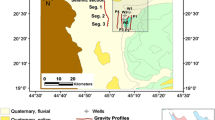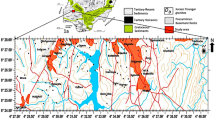Abstract
Due to increase in population and agricultural activities, the aquifer of Quetta Valley is under tremendous stress and the water table is declining at an increasing rate. This situation necessitates evaluation of the aquifer system, for which information about geometry of the aquifer is a prerequisite. However, there are no drilling-to-bedrock data available; therefore, electrical resistivity, seismic reflection and gravity methods were employed to determine geometry of the aquifer. Interpretation of vertical electrical soundings provided information about the depth-tobedrock at some specific points, whereas seismic reflection delineated bedrock topography along two lines. The depths to bedrock inferred from electrical resistivity and seismic reflection data were used as constraints in the modeling of gravity data. 2.75D gravity models were constructed along lines with a regular spacing. Map of depth-to-bedrock was prepared by contouring the depth given by the gravity models. Combination of these geophysical methods depicted the geometry of the aquifer. This example shows that in a similar geological setting proper integration of geophysical exploration methods can determine the aquifer geometry with an acceptable reliability and at an appropriate cost.
Similar content being viewed by others
References
Adiat, K.A.N., G.M. Olayanju, G.O. Omosuyi, and B.D. Ako (2009), Electromagnetic profiling and electrical resistivity soundings in groundwater investigation of a typical basement complex — A case study of Oda town, southwestern Nigeria, Ozean J. Social Sci. 2,4, 333–359.
Al Farajat, M. (2009), Characterization of a coastal aquifer basin using gravity and resistivity methods: A case study from Aqaba in Jordan, Acta Geophys. 57,2, 454–475, DOI: 10.2478/s11600-009-0001-1.
Blakely, R.J. (1995), Potential Theory in Gravity and Magnetic Applications, Cambridge University Press, Cambridge, 461 pp.
Bohidar, R.N., J.P. Sullivan, and J.F. Hermance (2001), Delineating depth to bedrock beneath shallow unconfined aquifers: a gravity transect across the Palmer river basin, Groundwater 39,5, 729–736, DOI:. 10.1111/j.1745-6584.2001.tb02363.x.
Cannon, K.A. (2006), Water as a source of conflict and instability in China, Strat. Anal. 30,2, 310–328.
Cawthorne, C., and W.D.J. Sinclair (1972), An apparatus for density determination on very small solid samples, J. Phys. E 5,6, 531–533, DOI: 10.1088/0022-3735/5/6/010.
Farah, A., and M. Ali (1964), Gravity bases in West Pakistan, Geol. Surv. Pakistan Rec. 6,2, 12.
García-Abdeslem, J., J.M. Romo, E. Gómez-Treviño, J. Ramírez-Hernández, F.J. Esparza-Hernández, and C.F. Flores-Luna (2005), A constrained 2D gravity model of the Sebastián Vizcaíno Basin, Baja California Sur, Mexico, Geophys. Prospect. 53,6, 755–765, DOI: 10.1111/j.1365-2478.2005.00510.x.
Gupta, A.D., and M.S. Babel (2005), Challenges for sustainable management of groundwater use in Bangkok, Thailand, Int. J. Water Resour. D. 21,3, 453–464, DOI: 10.1080/07900620500036570.
Gupta, A.D., and P.R. Onta (1997), Sustainable groundwater resources development, Hydrolog. Sci. J. 42,4, 565–582, DOI: 10.1080/02626669709492054.
Henbest, O.J., D.C. Erinakes, and D.H. Hixson (1971), Seismic and resistivity methods of geophysical exploration, Tech. Rep., Soil Conservation Service, Engineering Division, United States Department of Agriculture, Washington, USA, 3.1–3.73.
Hinze, W.J. (1990), The role of gravity and magnetic methods in engineering and environmental studies, Geotech. Environ. Geophys. 1, 75–126.
Kazim, M.A., A.N. Rana, and M. Younus (2001), Geological map of Quetta Valley, Geological Survey of Pakistan, Quetta.
Kazmi, A.H., and S.Q. Reza (1970), Water supply of Quetta Basin, Balochistan, Pakistan, Geol. Surv. Pakistan Rec. 20,2, 97–138.
Kazmi, A.H., G. Abbas, and S. Younas (2005), Water resources and hydrogeology of Quetta Basin, Balochistan, Pakistan, Geol. Surv. Pakistan, Sp. Publ., 124 pp.
Kazmi, S.A.T. (1973), Geohydrology of Quetta Valley, Hydrogeology Directorate, Reclamation Division, Water and Power Development Authority, Pakistan, 72 pp.
Koefoed, O. (1979), Geosounding Principles, 1. Resistivity Sounding Measurements, 2nd ed., Methods in Geochemistry and Geophysics, 14A, Elsevier Scientific Publ., Oxford, 276 pp.
Kuhn, M., W.E. Featherstone, and J.F. Kirby (2009), Complete spherical Bouguer gravity anomalies over Australia, Aust. J. Earth Sci. 56,2, 213–223, DOI: 10.1080/08120090802547041.
Lashkaripour, G.R. (2003), An investigation of groundwater condition by geoelectrical resistivity method: A case study in Korin aquifer, southeast Iran, J. Spat. Hydrol. 3,1, 1–5.
Moritz, H. (1992), Geodetic Reference System 1980, J. Geodesy 66,187-192.
Nagi, A.W. (1986), Groundwater as major source of water supply in Quetta Valley, Seminar on Water Resources Development in Balochistan at Quetta (21–23 April 1986), Hydrogeology, Water and Power Development Authority, Quetta, Pakistan.
NW Geophys. Ass. (2004), User’s guide version 4.9, Northwest Geophysical Associates Inc., Corvallis, USA, 101 pp.
Ohaus Scale Corporation (2004), Operation manual, Cent-o-Gram Balance, New Jersey, USA.
Ozebo, V.C., R.K. Odunaike, and A.A. Balogun (2008), Identification of depth to top of limestone body within a concession at Ibese, southwestern Nigeria, using vertical electric sounding, OnLine J. Earth Sci. 2,3, 99–107.
Roach, M.J., D.E. Leaman, and R.G. Richardson (1993), A comparison of regional residual separation techniques for gravity surveys, Explor. Geophys. 24,4, 779–784, DOI: 10.1071/EG993779.
Rout, D.J., M.C. Dentith, and W.E. Featherstone (1995), A regional scale gravity survey of the Southern Cross Greenstone Belt, Western Australia, Explor. Geophys. 26,3, 233–240, DOI: 10.1071/EG995233.
Sazhina, N., and N. Grushinsky (1971), Gravity Prospecting, Mir Publ., Moscow, 491 pp. (translated from Russian).
Shiraiwa, S., and N. Ussami (2001), Gravity survey of the Pantanal Wetland: Data acquisition and processing, Rev. Bras. Geof. 19,3, 315–324, DOI: 10.1590/S0102-261X2001000300007.
Singh, S.B., and J. Stephen (2006), Deep resistivity sounding studies in detecting shear zones: A case study from the southern granulite terrain of India, J. Asian Earth Sci. 28,1, 55–62, DOI: 10.1016/j.jseaes.2004.09.014.
Telford, W.M., L.P. Geldart, R.E. Sheriff, and D.A. Keys (1988), Applied Geophysics, 1st Indian ed., Oxford and IBH Publ. Co. Pvt. Ltd., New Delhi, 860 pp.
Tondozi-keto, and L. Tianyou (2006), Modeling and interpreting gravity anomaly data in African Great Lakes region, Asian J. Inf. Technol. 5,2, 219–224.
UNDP (1982), Groundwater studies in selected areas of Baluchistan, Pakistan, Groundwater of the Pishin Lora basin, United Nations Development Programme, Tech. Rep. No. 4, 196 pp.
Van Overmeeren, R.A. (1981), A combination of electrical resistivity, seismic refraction, and gravity measurements for groundwater exploration in Sudan, Geophysics 46,9, 1304–1313, DOI: 10.1190/1.1441269.
Velpen, D.B.A. (1988), Resist: A computer program for the interpretation of resistivity sounding curves, An ITC M. Sc. Research Project, ITCD, Delft, The Netherlands.
WAPDA (1989), Groundwater mining in selected areas of Balochistan, Hydrogeology, Water and Power Development Authority, Quetta, Pakistan, 35 pp.
Wessel, P. (1988), An empirical method for optimal robust regional-residual separation of geophysical data, Math. Geol. 30,4, 391–408, DOI: 10.1023/A:1021744224009.
Zohdy, A.A.R., G.P. Eaton, and D.R. Mabey (eds.) (1974), Application of Surface Geophysics to Ground-Water Investigations, Techniques of Water Resources Investigations, United States Dept. of the Interior, Geological Survey, No. 116.
Author information
Authors and Affiliations
Corresponding author
Rights and permissions
About this article
Cite this article
Alam, K., Ahmad, N. Determination of aquifer geometry through geophysical methods: A case study from Quetta Valley, Pakistan. Acta Geophys. 62, 142–163 (2014). https://doi.org/10.2478/s11600-013-0171-8
Received:
Revised:
Accepted:
Published:
Issue Date:
DOI: https://doi.org/10.2478/s11600-013-0171-8




